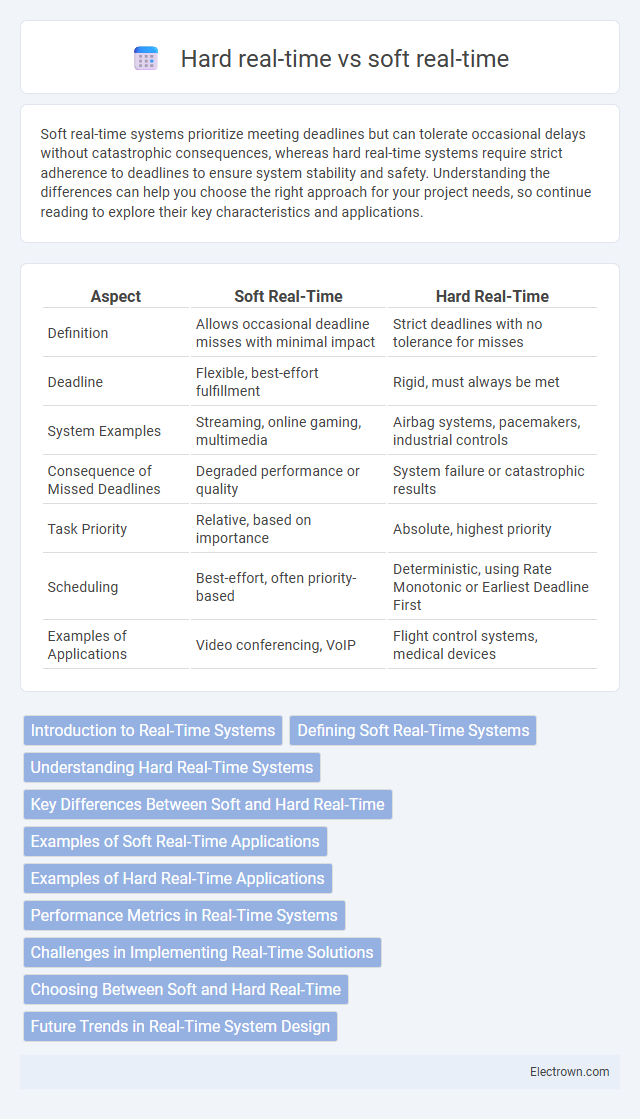Soft real-time systems prioritize meeting deadlines but can tolerate occasional delays without catastrophic consequences, whereas hard real-time systems require strict adherence to deadlines to ensure system stability and safety. Understanding the differences can help you choose the right approach for your project needs, so continue reading to explore their key characteristics and applications.
Table of Comparison
| Aspect | Soft Real-Time | Hard Real-Time |
|---|---|---|
| Definition | Allows occasional deadline misses with minimal impact | Strict deadlines with no tolerance for misses |
| Deadline | Flexible, best-effort fulfillment | Rigid, must always be met |
| System Examples | Streaming, online gaming, multimedia | Airbag systems, pacemakers, industrial controls |
| Consequence of Missed Deadlines | Degraded performance or quality | System failure or catastrophic results |
| Task Priority | Relative, based on importance | Absolute, highest priority |
| Scheduling | Best-effort, often priority-based | Deterministic, using Rate Monotonic or Earliest Deadline First |
| Examples of Applications | Video conferencing, VoIP | Flight control systems, medical devices |
Introduction to Real-Time Systems
Real-time systems are designed to process data and produce responses within strict timing constraints, crucial for applications like automotive control and medical devices. Hard real-time systems guarantee task completion within fixed deadlines to avoid catastrophic failures, whereas soft real-time systems prioritize timely responses but tolerate occasional deadline misses without severe consequences. Understanding the difference helps you choose the appropriate system for critical versus non-critical applications, ensuring reliability and performance aligned with specific operational requirements.
Defining Soft Real-Time Systems
Soft real-time systems prioritize timely task completion but allow occasional deadline misses without catastrophic consequences, making them suitable for applications like multimedia streaming and online gaming. These systems balance performance and flexibility by tolerating delays within acceptable thresholds, ensuring overall system responsiveness without stringent timing guarantees. Understanding your system's tolerance for latency and deadline adherence is crucial when defining a soft real-time environment.
Understanding Hard Real-Time Systems
Hard real-time systems require strict adherence to deadlines where missing even a single timing constraint can lead to catastrophic failures, making them crucial in applications like medical devices, automotive controls, and industrial automation. These systems prioritize deterministic behavior and guarantee task completion within predefined time limits to ensure safety and reliability. Your understanding of hard real-time systems is essential for designing mission-critical applications that cannot tolerate latency or unpredictability.
Key Differences Between Soft and Hard Real-Time
Soft real-time systems tolerate occasional deadline misses without catastrophic consequences, prioritizing average performance and flexibility, while hard real-time systems demand strict adherence to deadlines to ensure system safety and functionality. Soft real-time applications include multimedia streaming and online gaming, where occasional delays are acceptable, whereas hard real-time applications are critical in aerospace control systems and medical devices, where timing failures can cause severe damage or loss of life. Scheduling algorithms in hard real-time systems guarantee deadline compliance, unlike soft real-time systems which optimize for best-effort execution.
Examples of Soft Real-Time Applications
Soft real-time applications, such as video streaming, online gaming, and voice over IP (VoIP), tolerate occasional delays without catastrophic failure, prioritizing responsiveness over strict timing guarantees. These systems allow minor deadline misses, ensuring smooth user experiences even under varying workloads. Your multimedia entertainment and communication platforms often rely on soft real-time processing to balance quality and performance effectively.
Examples of Hard Real-Time Applications
Hard real-time applications include systems where meeting deadlines is critical, such as pacemakers, anti-lock braking systems (ABS), and industrial robot controllers. These applications demand absolute deadline adherence to ensure safety and prevent catastrophic failures. Your systems relying on hard real-time constraints must guarantee deterministic response times under all conditions.
Performance Metrics in Real-Time Systems
Performance metrics in real-time systems distinguish soft real-time from hard real-time by their tolerance to deadline misses and timing constraints. Hard real-time systems demand strict adherence to deadlines, where missing a deadline can lead to catastrophic failures, thus emphasizing metrics like worst-case execution time (WCET) and deterministic latency. Soft real-time systems prioritize average response times and system throughput, allowing occasional deadline misses without critical consequences, focusing on metrics such as jitter and mean response time for performance assessment.
Challenges in Implementing Real-Time Solutions
Implementing real-time solutions involves significant challenges, especially when distinguishing between soft real-time and hard real-time systems. Hard real-time systems require guaranteed response times, creating strict deadlines that demand precise task scheduling, predictable communication, and robust hardware reliability. Soft real-time systems allow some deadline flexibility, but you must still address issues like latency variability and resource contention to maintain acceptable performance and minimize deadline misses.
Choosing Between Soft and Hard Real-Time
Choosing between soft real-time and hard real-time systems depends on the criticality of task deadlines and system reliability requirements. Hard real-time systems guarantee strict deadline adherence, essential for safety-critical applications like medical devices or automotive controls, while soft real-time systems allow occasional deadline misses, suitable for multimedia streaming or gaming. Evaluating your application's tolerance for scheduling delays and consequence of failure guides selecting the appropriate real-time system type.
Future Trends in Real-Time System Design
Emerging technologies like AI integration and edge computing are shaping the future of real-time system design, bridging the gap between soft real-time and hard real-time requirements. Enhanced predictability and adaptive scheduling algorithms improve system responsiveness while maintaining strict deadline guarantees, essential for hard real-time applications. Your ability to leverage these advancements will determine the efficiency and reliability of next-generation real-time solutions.
Soft real-time vs hard real-time Infographic

 electrown.com
electrown.com